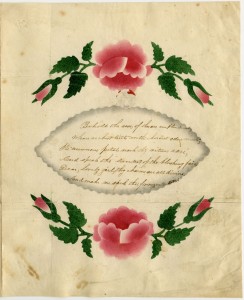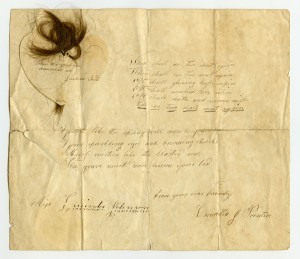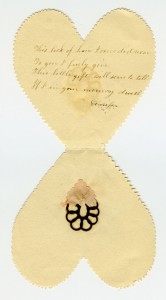 In 2010, the Graphic Arts department will be evaluating and re-housing its collection of nineteenth-century valentines. We have over 3,000 of these lacy, be-flowered paper objects and they are being sorted to provide better access for readers. Due to the high number and complexity of each object (some have moving parts, accompanying envelopes, etc., while others require elaborate folds) the project will be spread out over multiple calendar years. These items call out for individual blog entries, so expect a few!
In 2010, the Graphic Arts department will be evaluating and re-housing its collection of nineteenth-century valentines. We have over 3,000 of these lacy, be-flowered paper objects and they are being sorted to provide better access for readers. Due to the high number and complexity of each object (some have moving parts, accompanying envelopes, etc., while others require elaborate folds) the project will be spread out over multiple calendar years. These items call out for individual blog entries, so expect a few!
One area of the collection of particular importance is the manuscript valentines. These were handmade notes sent to a spouse, friend, or relative. They are often decorated with elaborate calligraphy, word puzzles, or watercolor drawings. The earliest dated manuscript valentine in the collection is a folded puzzle that was made in 1832. Other manuscript valentines in the collection, including a handwritten poem by Lucinda Prentice for her cousin (at left & dating from before 1825) pre-date this example, but, as their sender did not choose to include the date in their salutation, they are temporarily relegated to the “not dated” portion of the manuscript collection (let this be a lesson to us all – always date your correspondence!).
valentines in the collection, including a handwritten poem by Lucinda Prentice for her cousin (at left & dating from before 1825) pre-date this example, but, as their sender did not choose to include the date in their salutation, they are temporarily relegated to the “not dated” portion of the manuscript collection (let this be a lesson to us all – always date your correspondence!).
As I have been processing the manuscript valentines, examining and foldering each item, I am struck by how many missives include human hair. There ar e locks of hair, whole ringlets, and impossibly small looped braids of hair. Poetic verses such as: “Remember me when this lock you see,” and “This lock of hair I once did wear,” appear frequently with accompanying hair decorations glued, sewn and pasted down in all sorts of creative ways.
e locks of hair, whole ringlets, and impossibly small looped braids of hair. Poetic verses such as: “Remember me when this lock you see,” and “This lock of hair I once did wear,” appear frequently with accompanying hair decorations glued, sewn and pasted down in all sorts of creative ways.
All of these “hairy Valentines” caused me to think about how the perception of human hair has shifted over the centuries. If I suggested to my eleven year old that she make a decoration out of her hair to send to her best friend or grandmother, I am fairly certain that the response would be, “Mom, that’s gross!” And I am not at all sure what my own reaction would be to opening a letter and having a curl fall into my lap – I imagine there might be shrieking involved. 
But in the 1840s and 1850s, hair was used for all sorts of craft projects, with periodicals like Godey’s Ladies Book offering design suggestions for homemade jewelry, buttons, and even elaborate hair pictures for framing. The Society’s miniature collection features a likeness of Andrew Craigie, Jr. in a locket case backed by intricately woven hair. The daguerreotype collection includes several images of the Barton family (including the famous Clara at a young age) with scraggly lengths of hair pinned inside the cover of each case. Hair occasionally turns up in books, too, such as the curl pressed into an 1845 New England primer in the Society’s collection, which is accompanied by the inscription: “My youngest brother’s locks.” The business side of the hair market is documented elsewhere in the collection, including a c. 1806 trade card for a Salem jeweler who states, “Hairwork neatly executed,” and a 1870s broadside from New York with wholesale prices for “human hair and hair goods.”
In her 2007 publication Love Entwined: The Curious History of Hairwork in America, author Helen Sheumaker writes, “Revulsion, squeamishness, curiosity and sometimes a sentimental cooing: these have been the principal responses to hairwork that I have encounters in the years I have researched its history” (p. vii). The valentines are no exception, having elicited grimaces, gasps and questions from researchers and staffers as they pass by my work space where the valentines are spread out for examination. So, this coming Valentine’s day consider our ancestor’s acceptance of human hair as token of affection and make your own decision on what to include in a card for your Valentine. My family and friends will all hopefully stick with flowers and chocolate!

I was working in a collection at the Huntington where the finding aid noted that the last box contained “realia” including braids of hair. Oh cool, I thought, it’ll be interesting to see what color this person’s hair was (since I’d only seen black-and-white images of her). But when I finally got to that box, it wasn’t as cool as I expected–it was a bit of sensory overload, maybe. I put it away almost immediately.